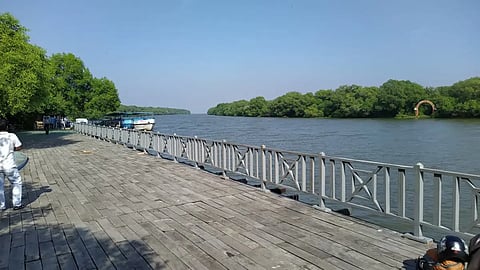A Heritage Village in Himachal Pradesh
Spotting Petroglyphs To Fireflies In Forests: 6 Little-Known Places To Discover In India
Remote sanctuaries, geological monuments, heritage villages and fireflies... There's a whole lot left to discover in India
Located in the Banjar tehsil of Kullu, Bahu is a small village at just over 2,000 metres above sea level, and is a great place to visit for a look into ancient temples and shrines. A number of hiking trails passing through this hamlet, and the scenic hike to the Baloo Nag Ttemple is well worth the huffing and puffing. The Sheshnag Temple is another hotspot. With meadows as far as the eye can see, Bahu is a heritage village that boasts of architecture from times past. There is also a road safety shrine made of old tyres and other vehicular parts, one of many in the region. The village is full of wood and stone houses with stone-tiled roofs, and is speckled with a variety of statues.
Ma Mauliksha Temples in Jharkhand
72 terracotta temples stand in a quiet huddle in the district of Dumka. Do a quick search online, and you barely find any intel. But there’s centuries of lore hidden within. The Maluti Temples were built as edifices to Bengal’s Pala rulers, followers of the Mahayana and Tantric Schools of Buddhism. The original tally was apparently 108, but mismanagement—a problem the Global Heritage Fund still identifies at the location, centuries later—caused several to bite the dust. The current ‘survivors’ portray scenes from the Ramayana and the Mahabharata, and are built in the Bengali Hindu temple style. The principal building (and deity) at Maluti is of Ma Mauliksha, a goddess curiously absent from Hindu scriptures. However, she finds some resonance with Vajrayana deity Pandara, a feminine bodhisattva. Legends place Mauliksha as the elder sister of goddess Tara (of pilgrimage site Tarapith, in West Bengal). A family reunion, then, could happen a mere 23 kilometres away.
Terracotta Plaques in Pilak
Deep in the heart of Belonia in south Tripura, Pilak is a hotbed for religious art from the 8th and 9th centuries. Speckled with terracotta plaques, stupas, stone figurines and images of the bodhisattva Avolokiteswara and Narasimhan, it also hosts a three-day archaeological festival each year. Pilak also has close relations with Buddhist sites across the border, namely Mainamati and Paharpur in Bangladesh. Its images are reminiscent of the heterodogeneous creeds and sects of Hinduism and Buddhism. The Archaeological Survey of India has recently been excavating Pilak more, in order to further understand the region and its history.
Mangroves in Coringa

The Coringa Wildlife Sanctuary is one of the largest stretches of mangroves along India’s eastern coast. The estuary region boasts of a unique biodiversity, with rare mangrove species, fishing cat, sea turtles, and otters. The sanctuary also has over 250 species of birds, of which nearly half are migratory, flying in from Central and Northern Asia, and Eastern Europe—seagulls, little egrets, brahminy kites, reef herons, black-capped kingfisher, and more. You can also find white-back and long-billed vultures here. The sanctuary has a ‘marine protected’ area, which houses over 80,000 water birds and about two dozen species of threatened birds. Spread across 235 sq km, Coringa’s ecosystem provides significant environmental as well as economic benefits. It protects the shoreline from erosion, cyclones, storms and tsunamis. It is also home to important nesting sites for Olive Ridley turtles and green turtles, and has over 200 species of breeding fin and shellfish.
Petroglyphs in Kharu
Petroglyphs are remnants of the past—a story of past civilisations and the evolvement of history. The petroglyphs of Ladakh can be found alongside the Indus and are said to have been created between the 2nd and 3rd millennium BCE. The 500-odd petroglyphs are best preserved in the Domkhar Rock Art Sanctuary, about 160 kilometres from Leh. The other notable areas in Ladakh are Kharu, Khaltse and Tangtse, that boast of similar ancient rock carvings. The shapes chiseled on the rocks speak of a different time—line drawings of animals on a dark surface, to give us a hint of the past and cultural migration patterns. It is believed that the rudimentary script on the rock surface is similar to those found among tribes of Central Asia, who lived a nomadic life 2,000 years ago.
Fireflies in Maharashtra
When Cold Play sang ‘lights will guide you home’ they surely couldn’t have known about Purushwadi’s magical fireflies. Streetlights are passé in this little village in the Akole district, about six hours away from Mumbai. Come May-June, this area becomes a hotspot for fireflies, millions and millions of them lighting up once night falls. The picturesque village is made up of about 100 families, some of whom, through an NGO, play host to visitors who come to see the spectacle. In the morning, one can walk around the village and pick berries straight off fruit trees, visit the nearby dam, help villagers in their agricultural fields, and eat a sumptuous home-cooked meal. But come nightfall, the scenery changes—if you’ve read Enid Blyton’s description of an enchanted forest, the experience isn’t far off. Villagers would earlier keep the fireflies in bottles to use as a light source but the practice has now fallen out of favour. See grassroutes.co.in